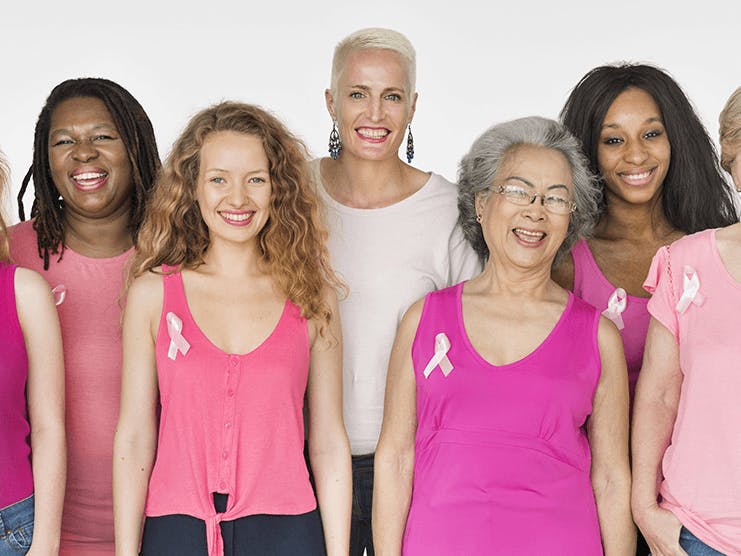
Diagnosing breast cancer early is the key to beating the disease.
Breast cancer is one of the most common cancers affecting women in America, with 1 in 8 women developing the disease in her lifetime. Men can also be affected by breast cancer, which is caused when cells in the breast grow out of control.
In 2021, more than 280,000 new cases of invasive breast cancer will be diagnosed in women. However, there are also nearly 4 million breast cancer survivors in the U.S.
There are different types of breast cancer, and it can begin in different parts of the breast. Being aware of signs and symptoms of breast cancer, as well as risk factors, how to detect breast cancer early, and Medicare coverage for screenings and treatment can help ensure you know what to look for and what to do if you receive a breast cancer diagnosis.
How do you know that you have breast cancer?
It's important for women to be familiar with how their breasts normally look and feel, and what's average for one woman may not be for another. For example, your breasts may change as you age, are menstruating, as you have children, if you gain or lose weight, or even by taking certain medications. Being aware of these changes and what can cause them is an important part of early detection.
Types of breast cancer
Breast cancer can start or be found in different parts of the breast. There are several different types of breast cancer determined by the specific cells in the breast that are affected.
Most breast cancers are tumors known as a carcinoma. They start in the epithelial cells that line the organs and tissues throughout the body. When formed in the breast, they can cause a more specific diagnosis such as adenocarcinoma, which starts in the cells of the milk ducts or the lobules.
- Ductal carcinoma in situ (DCIS) is a non-invasive or pre-invasive breast cancer that starts in a milk duct and has not grown into the rest of the tissue.
- Invasive breast cancer (ILC or IDC) is when the cancer has spread into the surrounding tissues. It makes up about 70-80% of all breast cancers. IDC begins in the cells that line the milk duct in the breast and grows into nearby breast tissue. ILC starts in milk-producing glands and can spread to other parts of the body.
Other, less common types of breast cancer may include:
- Triple-negative breast cancer
- Inflammatory breast cancer
- Paget disease of the breast
- Angiosarcoma
- Phyllodes tumor
Different types of breast cancer can cause different signs or symptoms, but most can be found on a screening mammogram before symptoms even develop. It's important to get screening mammograms when recommended by your provider.
Signs of breast cancer
The most common symptom of breast cancer is a new lump or mass. The lump can be painless, hard, and irregular, or tender, soft, or round. It may also be painful. However, other signs to look out for include:
- Swelling of part or all of the breast
- Skin dimpling (like an orange peel)
- Breast or nipple pain
- Nipple retraction (turning inward)
- Nipple or breast skin that is red, dry, flaking, or thickened
- Nipple discharge (other than milk)
- Swollen lymph nodes (under the arm or around the collar bone)
- Changes in size or shape of the breast
- A change in color of the breast skin
Keep in mind symptoms can be caused by other things and may not mean breast cancer, but you should talk to your provider right away to get any additional screenings or tests you may need. Your provider can help you determine whether something you notice is cause for concern, or if it's a benign condition.
Risk factors for breast cancer
Having one or more breast cancer risk factors doesn't necessarily mean you'll develop the disease, but it's important to be aware of what may put you at a higher risk. These factors may include:
- Being female, because women are much more likely than men to develop breast cancer
- Older age, because your risk increases as you get older
- History of breast conditions, such as a breast biopsy that found lobular carcinoma in situ (LCIS) or atypical hyperplasia
- A personal history of breast cancer in one breast increases your chances of developing cancer in the other breast
- Family history of breast cancer, especially in your mother, sister, or daughter
- Inherited genes that cause cancer risk, such as the BRCA1 and BRCA2 genes, which can be passed from parents to children
- Radiation exposure
- Obesity
- Beginning menopause at an older age
- Having your first child at an older age, especially after age 30
- Having never been pregnant
- Postmenopausal hormone therapy that combines estrogen and progesterone to treat signs and symptoms of menopause may increase your risk, which can decrease if you stop taking those medications
- Drinking alcohol
You can lower your risk by getting regular breast cancer screenings and performing breast self-exams, drinking alcohol in moderation (if at all), exercising regularly, limiting postmenopausal hormone therapy, maintaining a healthy weight, and following a healthy diet.
Medicare coverage for breast cancer screenings
Original Medicare Part B covers screenings you may need to detect breast cancer early, including mammograms and physical exams.
Mammogram coverage includes:
- One baseline mammogram if you're a woman between the ages of 35 and 59
- Screening mammograms once every 12 months if you're a woman aged 40 or older
For these screenings, you'd pay $0 as long as the provider accepts assignment. Diagnostic mammograms are covered more frequently if medically necessary and you'd pay 20% of the Medicare-approved amount (and the Part B deductible applies).
Medicare also covers one Pap test and pelvic exam every 24 months and as part of that exam, Medicare covers a clinical breast exam.
Medicare coverage for breast cancer treatment
If you are diagnosed with breast cancer, both Part A and Part B cover different parts of your treatment. For example, Part A would cover:
- Inpatient hospital stays, including cancer treatments you get while an inpatient
- Skilled nursing facility care (after a qualifying 3-day hospital stay)
- Home health care
- Hospice care
- Blood
- Surgery
Part B would cover other medically necessary cancer-related services and treatments such as:
- Doctors' visits
- Some chemotherapy drugs, including intravenous or oral treatments
- Radiation treatments given at an outpatient clinic
- Diagnostic tests (such as x-rays and CT scans)
- Durable medical equipment (DME)
- Outpatient surgeries
- Mental health services
Specific to breast cancer treatment, Medicare also covers:
- Surgically implanted breast prostheses after a mastectomy – Part A would cover if implanted in an inpatient setting, and Part B if it takes place in an outpatient setting
- External breast prostheses, including a post-surgical bra
Co-payments, co-insurance, or deductibles may apply for each service, and you must continue to pay your Part B premium. To learn how much a test, item, or service would cost, contact Medicare or talk to your provider.
Importance of early detection
The good news is breast cancer can be caught early and, in most cases, treated. The chance that a woman will die from breast cancer is only about 2.6%, which is about 5% lower than it was in 2013. This decrease in mortality rate is credited to early detection thanks to breast cancer screenings, better treatment, and increased awareness.
For those who are average risk for breast cancer, the American Cancer Society recommends these screenings guidelines:
- Women between 40 and 44 can start screening with a mammogram every year
- Women 45 to 54 should get a mammogram every year
- Women 55 and older can get a mammogram every other year, or every year if they prefer
A mammogram can help find breast cancer at an early stage, when treatment would be most successful. While they are not perfect, they are a key part of early detection. In fact, 63% of breast cancer cases are diagnosed at a localized stage, which means there is no sign the cancer has spread outside of the breast.
When breast cancer is found early, meaning it's small and has not spread, it's easier to treat successfully.
Additional resources
Breast Cancer
External Website Link
Breast Cancer in Men
External Website Link
What Is Breast Cancer?
External Website Link
Breast Changes and Conditions
External Website Link
What Are the Signs and Symptoms of Breast Cancer?
External Website Link
Breast Cancer
External Website Link
Breast Cancer Facts
External Website Link
Medicare Coverage of Cancer Treatment Services
External Website Link
Medicare & Cancer Care: What Happens if You Lose Your Hair?
Internal Website Link
Does Cancer Treatment Centers of America Accept Medicare?
Internal Website Link


